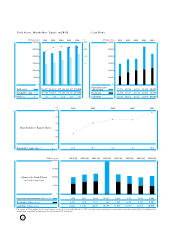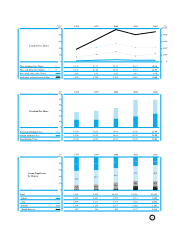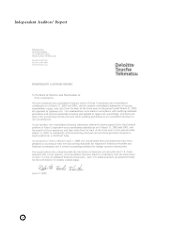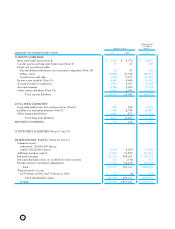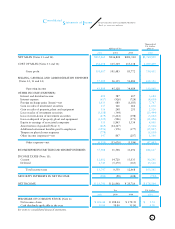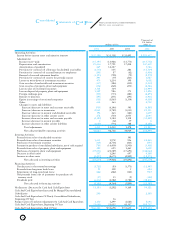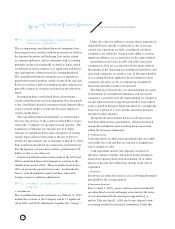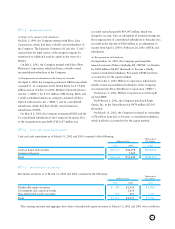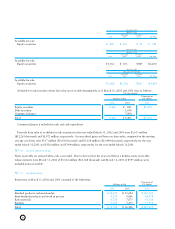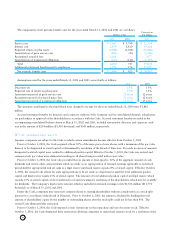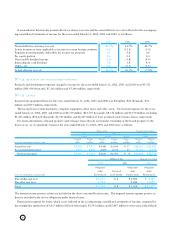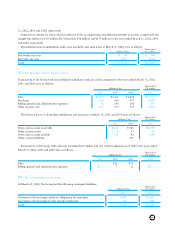Pentax 2002 Annual Report Download - page 39
Download and view the complete annual report
Please find page 39 of the 2002 Pentax annual report below. You can navigate through the pages in the report by either clicking on the pages listed below, or by using the keyword search tool below to find specific information within the annual report.
37
No»1basis of presenting consolidated
financial statements
The accompanying consolidated financial statements have
been prepared in accordance with the provisions set forth in
the Japanese Securities and Exchange Law and its related
accounting regulations, and in conformity with accounting
principles and practices generally accepted in Japan, which
are different in certain respects as to application and disclo-
sure requirements of International Accounting Standards.
The consolidated financial statements are not intended to
present the financial position, results of operations and cash
flows in accordance with accounting principles and practices
generally accepted in countries and jurisdictions other than
Japan.
In preparing these consolidated financial statements,
certain reclassifications and rearrangements have been made
to the consolidated financial statements issued domestically in
order to present them in a form which is more familiar to
readers outside Japan.
The consolidated financial statements are stated in Japa-
nese yen, the currency of the country in which Hoya Corpo-
ration (the “Company”) is incorporated and operates. The
translations of Japanese yen amounts into U.S. dollar
amounts are included solely for the convenience of readers
outside Japan and have been made at the rate of ¥133 to
U.S.$1, the approximate rate of exchange at March 31, 2002.
Such translation should not be construed as representations
that the Japanese yen amounts could be converted into U.S.
dollars at that or any other rate.
Certain reclassifications have been made in the 2001 and
2000 consolidated financial statements to conform to the
classifications used in 2002. These reclassifications had no
effect on previously reported net income. As described in
Note 2, total shareholders’ equity had been reduced by
foreign currency translation adjustments.
No»2summary of significant accounting
policies
a. Consolidation
The consolidated financial statements as of March 31, 2002
include the accounts of the Company and its 51 significant
(46 in 2001 and 2000) subsidiaries (together, the “Group”).
Under the control or influence concept, those companies in
which the Parent, directly or indirectly, is able to exercise
control over operations are fully consolidated, and those
companies over which the Group has the ability to exercise
significant influence are accounted for by the equity method.
Investments in two (four in 2001 and 2000) associated
companies in 2002 are accounted for by the equity method.
Investments in the remaining unconsolidated subsidiaries and
associated companies are stated at cost. If the equity method
of accounting had been applied to the investments in these
companies, the effect on the accompanying consolidated
financial statements would not be material.
The differences between the cost and underlying net equity
of investment in consolidated subsidiaries and associated
companies accounted for by the equity method are charged to
income when incurred, except that goodwill of some subsid-
iaries acquired in Europe is being amortized on a straight-line
basis over a period of 5 years and the amortized amount is
included in other expenses.
All significant intercompany balances and transactions
have been eliminated in consolidation. All material unreal-
ized profits included in assets resulting from transactions
within the Group are eliminated.
b. Cash Equivalents
Cash equivalents are short-term investments that are readily
convertible into cash and that are exposed to insignificant
risk of changes in value.
Cash equivalents include time deposits, certificate of
deposits, commercial paper and mutual funds investing in
bonds that represent short-term investments, all of which
mature or become due within three months of the date of
acquisition.
c. Inventories
Inventories are primarily stated at cost, cost being determined
principally by the average method.
d. Investment Securities
Prior to April 1, 2000, current and non-current marketable
securities listed on stock exchanges were stated at the lower
of cost, determined by the moving-average method, or
market. Effective April 1, 2000, the Group adopted a new
accounting standard for financial instruments. Under this
Hoya Corporation and Consolidated Subsidiaries
Notes to Consolidated Financial Statements


